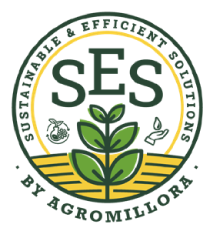Second Harvest of D’Agen Plums in Hedgerow System at Agrícola Cunculén Shows Outstanding Results
This year, Agrícola Cunculén is expected to produce over 13 tons of fresh fruit across 57 hectares in its second hedgerow plum harvest, with the goal of reaching over 35 tons at full production
Super-intensive planting system has caught the attention of both Chilean and international growers, as it promises to reduce costs throughout the entire production chain of this sought-after fruit
With high expectations and more than 150 attendees, Agrícola Cunculén held its second hedgerow-style harvest of D’Agen plums. The company, which specializes in the production and processing of this fruit, hosted a field day full of new information and excellent results in the town of Pencahue.
Gonzalo Guzmán, Agricultural Manager at Cunculén, shared: “The orchard we harvested is quite young (4 years old). The fruit size achieved in the first harvest was very uniform, and all the plums ripened evenly—unlike traditional orchards, where fruit doesn’t mature consistently across all trees.” This new system allows for high levels of mechanization in pest control, pruning, and harvesting. “By the end of the season, we expect about 13,000 kilos of fresh fruit. As traditional orchards lose productivity, our plan is to fully transition to the hedgerow system,” he added.
For growers, this system is highly recommended and is seen as the format of the future. “Adopting it wasn’t a leap of faith. We made the decision after a long time evaluating the pros and cons. Beyond the harvest itself, it brings significant savings in water, pesticide applications, fewer tractors needed to collect bins, and the mechanization enables faster pruning and, most importantly, a quicker and more cost-effective harvest compared to traditional methods,” he explained.
“By the end of the season, we expect about 13,000 kilos of fresh fruit. As traditional orchards lose productivity, our plan is to fully transition to the hedgerow system.”

The hedgerow system is a planting format that enables uniform production in pedestrian-accessible rows, characterized by high density and mechanization. It’s already used in crops like olives, almonds, plums, and citrus. “In the case of plums, there are over 10 years of trials. We believe this system allows for easier yield estimation and harvest planning, drone-based spraying, and, due to reduced foliage, lower water usage—potentially saving up to 30%,” said Mauricio Zúñiga, Key Account Manager at Agromillora Sur.
Agromillora estimates that this model saves about $2,000 per season, considering various factors. “This system supports sustainable agriculture, thanks to significant water savings, reduced carbon footprint from quicker, more efficient harvesting. Traditional bin collection often requires three tractors per harvest team, which increases fuel use and soil compaction. Add to that the side-by-side harvesting machine, and traditional systems become more expensive and less efficient,” he noted.
Agrosolutions, a company specializing in leasing New Holland equipment for intensive harvesting—capable of collecting up to 20,000 kilos per day—has seen rising demand for this system. “This year has been a turning point, as the growth of our service has been organic. We initially focused on almonds and vineyards, and have now expanded to other fruits like plums. We expect to cover around 3,600 hectares this year—1,000 more than last year,” said Rafael Faundez, Operations Manager.
Pellenc Chile, which sells all-in-one machines like the Optimum XL—showcased during the field day—has experienced a similar trend. These machines are specially designed for fruit production. “With the slowdown in the wine industry, we’ve shifted focus to fruit crops, introducing machines that are gentler on fruit. Pellenc continually innovates to ensure the plant’s branches and spurs aren’t damaged during the shaking process,” said Esteban Balochi, Commercial Manager for Agricultural Machinery at Pellenc Chile. This machine has a 4,000-kilo discharge capacity and can harvest 5, 6, or more hectares over a 9-hour day.
International Interest in Chile’s Results
The hedgerow system for plum orchards implemented in Chile has sparked international interest from various industry players, particularly in the U.S., Argentina, and Spain. One example is Alfonso Cruz SL, a Spanish farming company from Extremadura, which grows nuts such as figs, apricots, and almonds. “We’ve been curious about D’Agen plum production for some time, and I had never seen a super-intensive plantation like this in Europe,” said Francisco Cruz, Administrator and General Manager of this family-owned business near Mérida.
“From what I’ve seen, we need to produce while saving—not just on labor—but by considering total production costs, since we can’t always anticipate things like international fruit prices,” he added.
Gonzalo Guzmán from Agrícola Cunculén shares a similar perspective. “The plum business is stable, but there are bad years depending on climate variability. This year is looking very promising in terms of both yield and prices, especially for dried plums, which are in high demand,” he noted.




